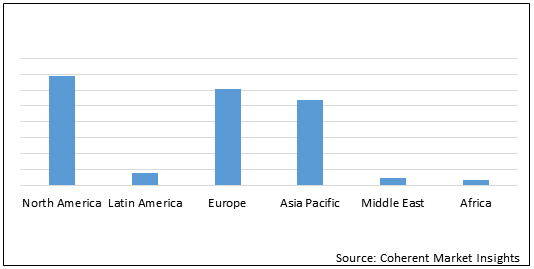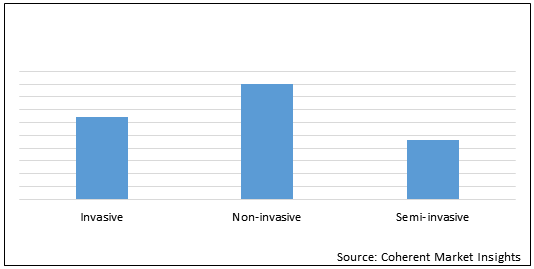views

Brain Computer Interface Market, by Product (Invasive, Non-invasive, and Semi-invasive), by Application (Prevention, Detection and Diagnosis, and Rehabilitation and Restoration), by End User (Hospitals, Academic Institutes, and Research Institutes), and by Region (North America, Latin America, Europe, Asia Pacific, Middle East, and Africa) - Size, Share, Outlook, and Opportunity Analysis, 2021 - 2028
Brain computer interface (BCI) is an emerging technology, which provides a direct communication between the brain and external device bypassing the normal neuromuscular pathways and helps in detecting and diagnosing various brain disorders such as epilepsy, brain tumors, as well as can restore the impaired motor functions.
The increasing prevalence of brain disorders, brain tumors, and disabilities due to stroke is expected to drive growth of the global brain computer interface market over the forecast period.
For instance, according to the study by Epilepsy Action Australia statistics in 2017, around 50 million people globally had epilepsy with around 80% of the people living in emerging economies such as India, Brazil, and China.
The global brain computer interface market is estimated to be valued at US$ 773.0 million in 2021 and is expected to exhibit a CAGR of 11.4% over the forecast period (2021-2028).
Figure 1. Global Brain Computer Interface Market Share (%) in Terms of Value, By Region, 2021

Increasing investment & funding to accelerate researches in the field of brain computer interface is expected to drive the market growth over the forecast period
Market players are focusing on various growth strategies such as investments and funding to accelerate researches in the field of brain computer interface, which is expected to boost growth of the global brain computer interface market over the forecast period.
For instance, in December 2020, researchers of Bioelectronics Laboratory of Department of Engineering, University of Cambridge received funding from the European Innovation Council (EIC) for their project MITICS – Mixed Ionic and electronic transport in conjugated polymers for bioelectronics, which is being carried out to develop microelectronics, in order to enhance signal quality of a new generation of less invasive brain-computer interfaces (BCIs).
Neuralink Corporation, Neurable, Emotiv Inc., BitBrain, Alpha Omega, Blackrock Microsystems, LLC, Femtonics Ltd, NeuroNexus, Opto Circuits (India) Limited, BIOTRONIK, Plexon Inc., Noldus Information Technology, NextMind, Nectome, and Paradromics
Figure 2. Global Brain Computer Interface Market Share (%), by Product, 2021

The increasing prevalence of brain tumors is another major factor, which is expected to drive the market growth. For instance, according to the National Brain Tumor Society, a non-profit organization in the U.S., around 84,170 cases of primary brain tumor are expected to be diagnosed in 2021 in the U.S., out of which around 59,040 tumors are estimated to be benign (non-malignant), while 25,130 will be malignant.
Global Brain Computer Interface Market – Impact of Coronavirus (Covid-19) Pandemic
The lockdown imposed in most of the countries has placed an economic burden on the private healthcare sector. Healthcare providers are facing challenges in terms of additional manpower, equipment, consumables, and other resources required to ensure safety in hospitals and to provide treatment to patients with other diseases.
Moreover, the coronavirus pandemic has hampered the development, production, and supply of drugs and other healthcare products, and affected growth of healthcare businesses of various companies across the globe.
Considering the implication of social distancing measure, the footfall in clinics and health institutions has fallen by over 70% during this pandemic. Owing to this, the adoption of digital health services has increased by three-fold.
However, healthcare IT industry has witnessed paradigm shift in the adoption of healthcare IT solutions across the ecosystem including drug discovery, drug development, diagnostics, data management, marketing, and patient engagement. Artificial Intelligence, electronic health record (EHR), revenue cycle management, reimbursement data management, and clinical data management solutions are being rapidly adopted by companies, including Contract research organization (CROs), insurers, diagnostics, and research institutes for remote data monitoring.
Global Brain Computer Interface Market Restraint
Brain computer interfaces technology has proven to be useful for both medical as well as non-medical fields such as smart environment, games, safety, and others. However, there are several challenges associated with the technology, which can hinder the market growth in the near future. The challenges are summarized in the following categories:
Neuro-psycho-physiological issues: Brain is the most complex organ of human body. Hence, the genetic complexity and diversity of brain creates neurological challenges, while using the brain computer interfaces technology. Psychological challenges include parameters such as attention, fatigue, stress, and other emotions, which depend on individual personality.
Key Players
Major players operating in the global brain computer interface market include Neuralink Corporation, Neurable, Emotiv Inc., BitBrain, Alpha Omega, Blackrock Microsystems, LLC, Femtonics Ltd, NeuroNexus, Opto Circuits (India) Limited, BIOTRONIK, Plexon Inc., Noldus Information Technology, NextMind, Nectome, and Paradromics
Brain computer interface is a technology, which receives, analyzes, and transfers signals from brain to output commands to achieve certain task such as restoration of movement and communication strength for physically disabled patients in order to rehabilitate their lost motor abilities. Brain computer interfaces can be divided into following categories: Event related de-synchronization (ERD-BCI) and synchronization (ERS-BCI), Exogenous BCI and endogenous BCI and Active BCIs, Reactive BCI, and Passive BCI.
Market Dynamics
Increasing prevalence of neurological disorder is expected to drive the market growth over the forecast period.
Moreover, according to the World Health Organization (WHO), around one-third of children with epilepsy can be assigned to a specific epilepsy syndrome, as defined by the most recently proposed system for organization of epilepsy syndrome. For instance, according to the Society of Neuroscience, in 2015, epilepsy affected around 10.5 million children worldwide, and the types and severity of the disorder varied significantly. Moreover, according to the American Academy of Pediatrics data published in April 2017, epilepsy affects 0.5% to 1% of children globally and is the most frequently occurring chronic neurologic condition in childhood.
Key features of the study:
Detailed Segmentation:
“*” marked represents similar segmentation in other categories in the respective section.
The market size is estimated to be valued at US$ 773.0 million in 2021 and is expected to exhibit a CAGR of 11.4% between 2021 and 2028.
Increasing investment & funding to accelerate researches in the field of brain computer interface and increasing prevalence of brain disorders are expected to drive the market growth over the forecast period.
Non-invasive product segment is expected to hold the major market share during the forecast period.
North America is expected to hold the largest market share in the global brain computer interface market.
Major factors hampering growth of the market include challenges associated with brain computer interface.
Major players operating in the market include Neuralink Corporation, Neurable, Emotiv Inc., BitBrain, Alpha Omega, Blackrock Microsystems, LLC, Femtonics Ltd, NeuroNexus, Opto Circuits (India) Limited, BIOTRONIK, Plexon Inc., Noldus Information Technology, NextMind, Nectome, and Paradromics
The market size is estimated to be valued at US$ 773.0 million in 2021 and is expected to exhibit a CAGR of 11.4% between 2021 and 2028.
Increasing investment & funding to accelerate researches in the field of brain computer interface and increasing prevalence of brain disorders are expected to drive the market growth over the forecast period.
Non-invasive product segment is expected to hold the major market share during the forecast period.
North America is expected to hold the largest market share in the global brain computer interface market.
Major factors hampering growth of the market include challenges associated with brain computer interface.
Major players operating in the market include Neuralink Corporation, Neurable, Emotiv Inc., BitBrain, Alpha Omega, Blackrock Microsystems, LLC, Femtonics Ltd, NeuroNexus, Opto Circuits (India) Limited, BIOTRONIK, Plexon Inc., Noldus Information Technology, NextMind, Nectome, and Paradromics
Artificial intelligence is the simulation of human intelli...
IT-enabled healthcare involves use of Clinical Information...
US Computer-aided Detection (CAD) Market – I...
Joining thousands of companies around the world committed to making the Excellent Business Solutions.
Kindly subscribe for our latest news & articles.












